Invented by Harold Frank Greer, Ryan Morrow Briggs, Nanoclear Technologies Inc
One of the key drivers of this market is the increasing demand for sustainable and energy-efficient solutions. Multifunctional surfaces can significantly reduce the need for chemical cleaning agents, water consumption, and energy usage. For instance, self-cleaning surfaces eliminate the need for regular cleaning, saving both time and resources. This makes them highly attractive to environmentally conscious consumers and businesses looking to reduce their carbon footprint.
In the construction industry, multifunctional surfaces offer numerous advantages. They can be applied to building facades, windows, and roofs, providing thermal insulation, UV protection, and self-cleaning properties. These surfaces can also help in reducing the maintenance costs associated with cleaning and repairing buildings. Additionally, the anti-reflective properties of these surfaces can enhance the energy efficiency of solar panels, making them more efficient in converting sunlight into electricity.
In the healthcare sector, multifunctional surfaces play a crucial role in maintaining a hygienic environment. The anti-bacterial properties of these surfaces help in preventing the spread of infections and diseases. They can be used in hospitals, clinics, and laboratories, where cleanliness and hygiene are of utmost importance. Furthermore, these surfaces can also be applied to medical devices and equipment, reducing the risk of contamination and improving patient safety.
The automotive industry is another sector where multifunctional surfaces are gaining traction. These surfaces can be used in car interiors, exteriors, and windshields, providing benefits such as scratch resistance, water repellency, and anti-fogging properties. Additionally, the self-cleaning capabilities of these surfaces can help in maintaining the aesthetics of vehicles, reducing the need for frequent car washes.
The electronics industry is also witnessing the adoption of multifunctional surfaces. These surfaces can be used in displays, touchscreens, and wearable devices, offering benefits such as improved visibility, reduced glare, and fingerprint resistance. The anti-reflective properties of these surfaces enhance the viewing experience, especially in bright environments. Moreover, the self-cleaning properties of these surfaces can help in keeping electronic devices free from dust and dirt.
As the demand for multifunctional surfaces continues to rise, companies specializing in this field are investing heavily in research and development to create new and improved materials. The market is highly competitive, with numerous players offering a wide range of products and solutions. Key players in this market include 3M, BASF SE, PPG Industries, and AkzoNobel.
In conclusion, the market for property control of multifunctional surfaces is witnessing significant growth due to the increasing demand for sustainable and energy-efficient solutions. These surfaces offer a wide range of benefits across various sectors, including construction, healthcare, automotive, and electronics. As technology advances and new materials are developed, the potential applications of multifunctional surfaces are only expected to expand further, making them an integral part of future industries.
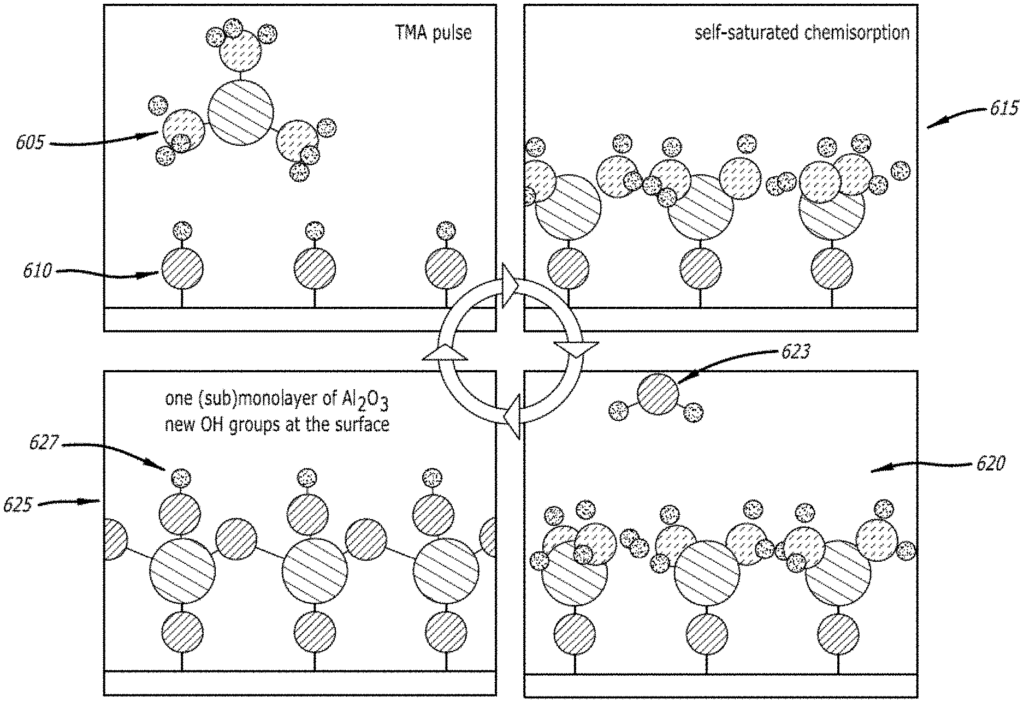
The Nanoclear Technologies Inc invention works as follows
The physical and chemical properties can be controlled using inorganic precursors to bond nanoparticles or microspheres. Surfaces can be modified to have desirable properties like antireflection and antifogging. They can also absorb IR, block UV light, and reduce ice formation. “Micro or nanomaterials are also used as etching stencils to control the physical and chemical properties of a surface via its micro- or nanotexture.
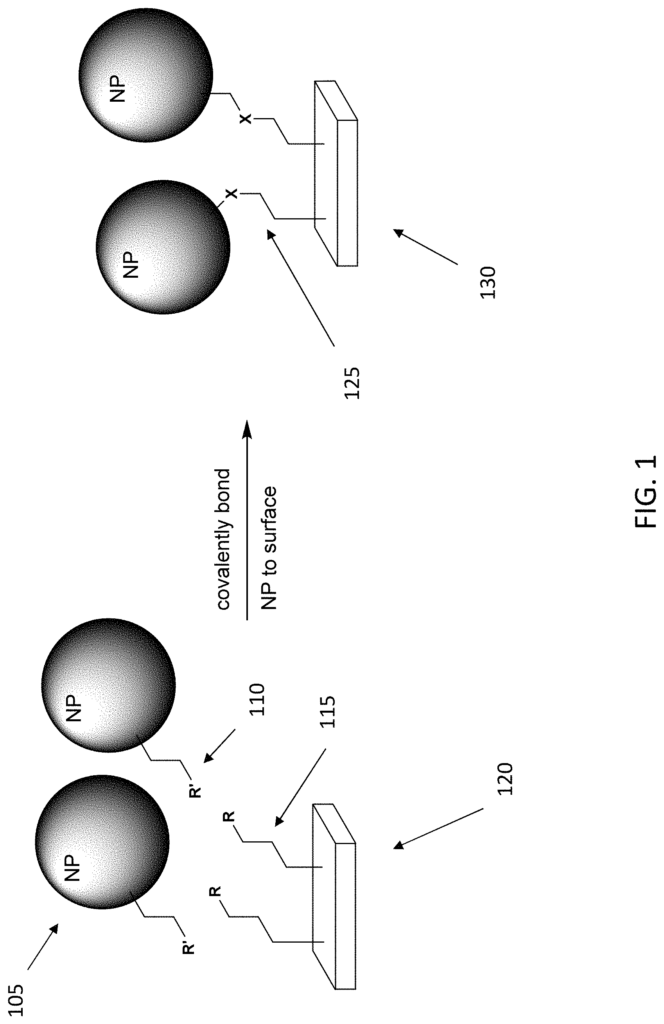
Background for Property Control of Multifunctional Surfaces
In a “first aspect” of the disclosure, it is described a method that includes: determining the first lateral dimensions of each of the elements in the structure on a flat surface. The first lateral dimensions are determined based upon a physical characteristic, and the second lateral dimensions are perpendicular and horizontal to the first.
The second aspect of this disclosure describes a method that includes: determining the height of each of the elements in relation to the surface, and a desired reflectivity of the electromagnetic radiation incident on the element. This height is in a vertical position relative to the area; determining the spacing between elements in relation to the desired transparency and the reflectivity.
In a third aspect, “a structure” is described. The structure consists of: an array on pillars, with each pillar having first and second dimensions x and z and height y, and a monolayer covering each pillar. X is between 50nm to 250nm thereby blocking UV radiation. Y is between 120nm to 180nm reducing reflected light. Each particle in the monolayer is less than 200nm wide and made from a material that can absorb inf
Several products already on the market include surface modifications and coatings to achieve specific physical, chemical or electrical properties. Deposition of nanoparticles onto the surface using a non-bonding method can be used to modify surface properties. These nanoparticles can be applied by spin, spray or dip coating processes. Nanoparticles can be applied to surfaces in a number of ways, including to enhance Raman or act as catalysts. These techniques are known by people with ordinary knowledge of the art and can be effective for certain applications. However, they may have some disadvantages. This is mainly because these techniques do not adhere the nanoparticles firmly to the surface. These techniques are not specific, they require extreme care when deposition is performed, and they do not attach nanoparticles to a surface uniformly. These processes may also not be able apply a uniform layer of nanoparticles to curved surfaces or non-uniform surfaces.
There are also other methods that are known to a person with ordinary skill, whereby nanoparticles can be bonded to a surface. Nanoparticles, for example, can be bonded with one base pair of complementary deoxyribonucleic acid (DNA), and the other base pair can then be bonded on the surface. This technique can create a single layer of nanoparticles, but it has some limitations. The nanoparticle layer will not be stable at high temperature because DNA denatures with heat. The DNA linkage might not be chemically resistant to strong acids/bases, or extreme solvents. Attaching DNA to the substrate is a complex process. The raw materials used for DNA attachment can be expensive.
The present disclosure describes methods for depositing monolayers nanoparticles using inexpensive and technologically simpler techniques that allow for a significantly greater control over chemical and physical properties (e.g. The surface that is coated with nanoparticles will have optical and electrical properties. This technique can be used to create three-dimensional structures that have multiple nanoparticle levels and sizes. This technique describes the modification of a surface using nanoparticles. However, the ability of coating multiple layers of uniform and conformal particles allows not only for the fabrication of novel surfaces but also of three-dimensional material and metamaterials.
In general, the methods described here are directed at applying a single nanoparticle layer on a surface substrate. The disclosed methods provide a uniform and stable coating on surfaces of all types (flat, curved or non-uniform). In certain embodiments, the particle size can range from nanometers to micrometers (e.g. microspheres). Different methods can be used to attach these particles, such as: 1. Organic bonding (click chemistry); 3. Organic bonding. (Click Chemistry); 3. Carefully controlled spraying or dipping. Fluids can be applied to particles and surfaces in distinct, successive steps, for example, to create bonds between the two. In separate steps, for example, the particles can be treated with a liquid spray or other application, and the surface can be treated with a liquid mixture. The excess liquid can be removed by using a solvent or solvent mixture, or drying. The liquids chosen for the first and second liquids must be able create an attractive force or bond between the particles and surface. This will result in a uniform monolayer. The technique can be modified in order to create hierarchical surfaces with multiple monolayers, or other structures. Organic chemistry can be used to carry out a similar process. Gases can be used instead of liquids. Fluids can also be called ‘precursors’, since they prepare surfaces for bonding or attraction forces between functional groups. In some embodiments the particle (or suspension of particles) is one of the two pre-cursors. In this instance, the particles are functionalized to make their surface reactive with the substrate. However, in other embodiments, the particles could be fabricated or formed so that they can attract. In this case, the particles can be prepared separately to make them a pre-cursor. The surface of the substrate is treated with the other precursor. The particle precursor will then adhere to the surface that has been treated with the other pre-cursor. The process is divided into the following steps. A first precursor is sprayed on the substrate or prepared in another way. Spraying a fluid or solvent mixture neat onto the substrate; The substrate is sprayed using a dispersion (the particles are precursors suspended in fluid). The substrate is sprayed neatly with solvent. The solvents and precursors are selected so that the functional groups can interact or not interact as desired. This allows for the application of a monolayer, while preventing the attachment of a secondary monolayer. If necessary, you can repeat the process to form a second layer. In some embodiments, particles can be sprayed onto the surface relying solely on physical interactions and without permanent bonds. The particles can be held together by van der Waals forces or electrostatic forces.
In some embodiments functional groups such as?OH or Al?CH3 can be used to bond the particles to the surface. This is a different approach from DNA-based methods, as DNA uses hydrogen bonds. These base pairs are linked by hydrogen bonds. These hydrogen bonds are denatured at high temperatures. The shape of DNA strands changes at high temperatures and the hydrogen bonds break up.
The nanoparticles that can be used in the methods are: metals, metal oxides and metal nitrides; carbon nanotubes; buckyballs. “Examples of nanoparticles used with the disclosed methods include, but are not limited to, metals and metal oxides. Metal nitrides. Buckyballs (e.g.
The disclosed methods can be used on a variety of substrates including, but not limited to: glass, ceramics and polymers; textiles or metals; semiconductors.
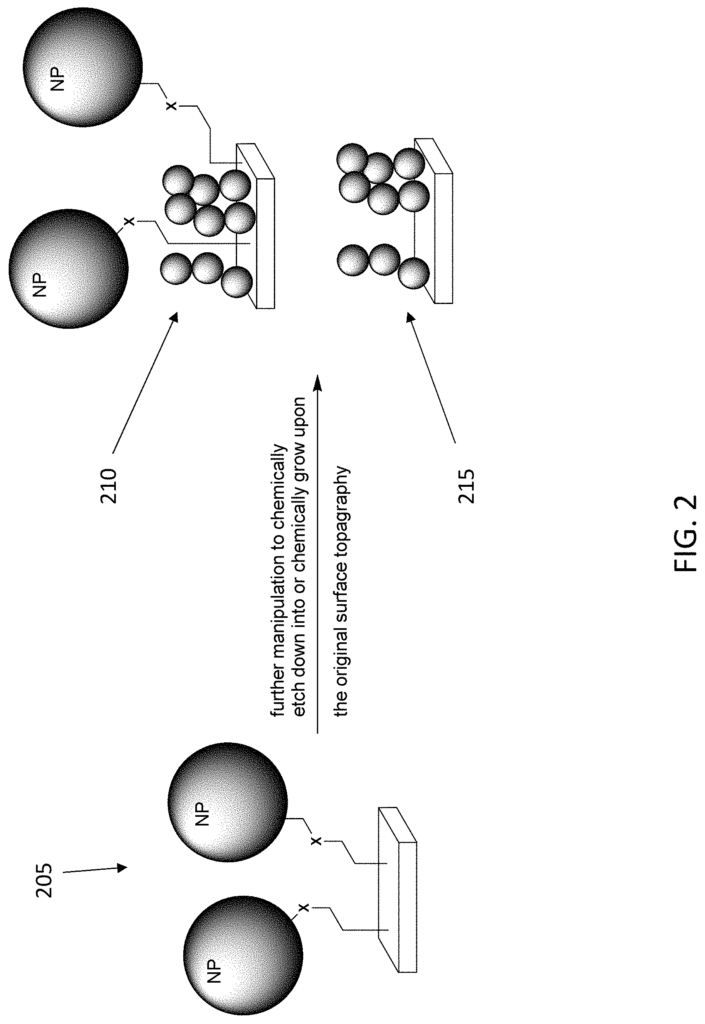
In some embodiments, liquid phase atomic-layer deposition is used to deposit a uniform, single layer of nanoparticles on any surface. ALD is a thin-film deposition method that involves the sequential application (e.g.) of precursor components. Two precursors are deposited onto a substrate where they interact chemically to form atomic bonding. ALD is a subclass in chemical vapour deposit, because the precursors are usually introduced as gas inside the deposition chamber. If the precursors in liquid form are used, then the technique is called liquid phase atomic-layer deposition, or solution atomic-layer deposition (sALD), as the precursors will be dissolved in an inert solvent.
In some embodiments, layers are created using a 3-step process. In the first step, nanoparticles functionalized by? ?OH? Alcohol groups. There are several different chemical methods to attach alcohol. ?OH? Functional groups can be added to a nanoparticle with any composition (for example, but without limitation, nanoparticles could comprise pure metals or oxides). In a subsequent step, the target surface (i.e. the surface to be coated) will be exposed to trimethylaluminum in a solution, vacuum chamber or any other method known in the art. This second step involves functionalizing the surface of the substrate with a? ?CH3? “or methyl groups.
In a third stage of this embodiment,? ?CH3? Functionalized substrates can be immersed in a? ?OH? Functionalized nanoparticles. The bath is made up of functionalized nanoparticles suspended within an organic solvent, such as hexane. The methyl groups on the substrate surface react with the alcohol or, more generically, ?OH group on the functionalized nanoparticles to form a sub strate-oxygen-nanoparticle (substrate-Al?O-nanoparticle) covalent bond, and a methane by-product (CH4) (which exits the bath as a dissolved gas, or bubbles out of the bath).
The covalent bond is responsible for permanently attaching the nanoparticles in one layer to the surface. When all the? ?CH3? The groups have been transformed into covalent bonds between nanoparticles. Nanoparticles approaching the surface will adhere loosely to the substrate but not form covalent bond. When the coated substrate has been removed from the bath, it will be rinsed. The loosely-bound nanoparticles are then removed and only the covalently-bonded ones will remain. This allows for the formation of a monolayer composed of covalently-bonded nanoparticles. Any nanoparticles that may have attached to the substrate as a second, third, etc. monolayer can be removed. Due to the fact that these possible multilayers nanoparticles have not been covalently attached to the substrate, they can be removed. Only the first layer of nanoparticles is covalently bound. In some embodiments the substrate may be rinsed after each step with an organic solvent, such as hexane. Hexane, for example, can be used to remove any nanoparticles that are weakly adhered as a second layer or additional layers. In some cases, the use of sonication to remove excess multilayers can be helpful.
In other embodiments, this process can be repeated indefinitely to build precise nanoparticle layers, one at a time. In this process, the first monolayer covalently bonded to the substrate is now functionalized?similarly to how the substrate had been functionalized in the first iteration. The second monolayer will covalently bond with the first monolayer. Any nanoparticles weakly bound as a third monolayer (e.g. rinsed off) can then be easily removed. Each iteration involves the deposition of a new monolayer. The nanoparticles of the subsequent layers can be identical with those in the initial layer. Alternately, different nanoparticles can be added to the following layers. Each monolayer can be made with different nanoparticles or sizes, or alternately two types. The choice of nanoparticle compositions in each layer allows for the fabrication of metamaterials and three-dimensional materials with any composition, material grade, or dimension. These assemblies may be referred to as’metamaterials. “Metamaterial” properties may include tunable (and possibly negative) indexes of refraction and cloaking.
In other embodiments, this process can be stopped prior to forming a monolayer of fully closed nanoparticles. In certain embodiments, it is not necessary to remove the excess multilayers of nanoparticles. In some embodiments, the process above does not need to be perfectly separated. In these embodiments the modifications to the ideal steps may compromise the quality of monolayers but could be used in order to reduce fabrication time. The process can be altered to trade-off between quality and fabrication ease, depending on tolerance for defects in the final application.
In other embodiments, an atomic layer is used to deposit a uniform, single layer of nanoparticles on any surface using a combination between gas phase and liquid phase. This method allows the surface of the substrate to be functionalized through exposure to TMA in gas phase. This first step can be performed, for instance, on a conveyor belt or other similar system that operates under atmospheric pressure. After the substrate has been functionalized with a?CH3 group, it is exposed to functionalized nanoparticles containing?OH groups by spray coating or other coating methods such as dip-coating in a nitrogen environment. The nanoparticles, in a similar way to what was described above will bond covalently to the surface.
The methods described above are summarized in the following way: Functionalization of nanoparticles, 2. Functionalization of substrate; 3. Covalent bonding a monolayer of nanoparticles onto the substrate. Both the first and second steps can be done in reverse or simultaneously. As noted above, either one or both of the nanoparticle-substrate combo can be bonding without pretreatment.
In other embodiments the three steps can be performed in a liquid phase or a gas phase with functionalizing agents, provided that the environment in which the functionalization and covalent bonding are performed is essentially free of water, OH-groups or other OH-groups other than those on the nanoparticles. These additional?OH group may interfere with methods by bonding nanoparticles to other surfaces, not the target surface. Any of the embodiments can be carried out in batch mode or as a continuous conveyor belt process. In one embodiment, for example, and without limitation, a substrate placed in a zone is sprayed in liquid TMA. The substrate is moved to a 2nd zone and sprayed with a neat (a stoichiometric) solvent to remove any unreacted TMA. The substrate is then moved to a second zone, where functionalized nanoparticles are sprayed onto the surface of the substrate. The substrate moves on to a third zone where functionalized nanoparticles are sprayed onto the substrate surface.
In other embodiments the nanoparticles can be functionalized using TMA, and the substrate surface may also be functionalized by alcohol groups. TMA may be substituted in other embodiments for any of the reactive precursors that are used during gas phase atomic vapour deposition, including but not limited, to chlorides, fluorides or organometallics. In other embodiments the?OH can be replaced with other functional groups such as an ester, amine, aldehyde, halide or any other group known in the art. Other embodiments can extend the functionalized groups by adding a carbon ring between the nanoparticles and their functional group, e.g. the?OH group, and/or by adding a ring between the substrate and the functional group, e.g. the ‘CH3 group.
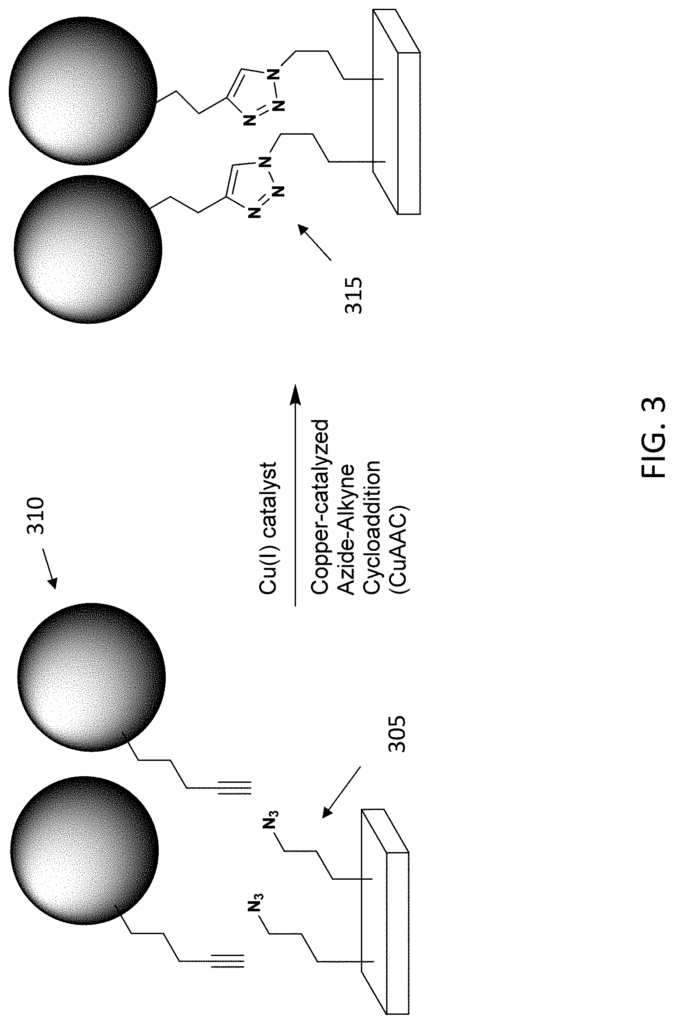
The methods described in this document can be used with other processes or to modify the surfaces of existing products. Surfaces with covalently bonded nanoparticles can, for example, be used to mask subsequent etching. In other applications the covalently-bonded nanoparticles are used to allow solar cells to absorb light of different wavelengths. The solar cell substrate can be made to absorb light in different wavelengths from the nanoparticles. This will increase the energy collected by the tandem cell compared to a single terminal cell. The modified surfaces can be used to scatter light on the bottoms of solar cells.
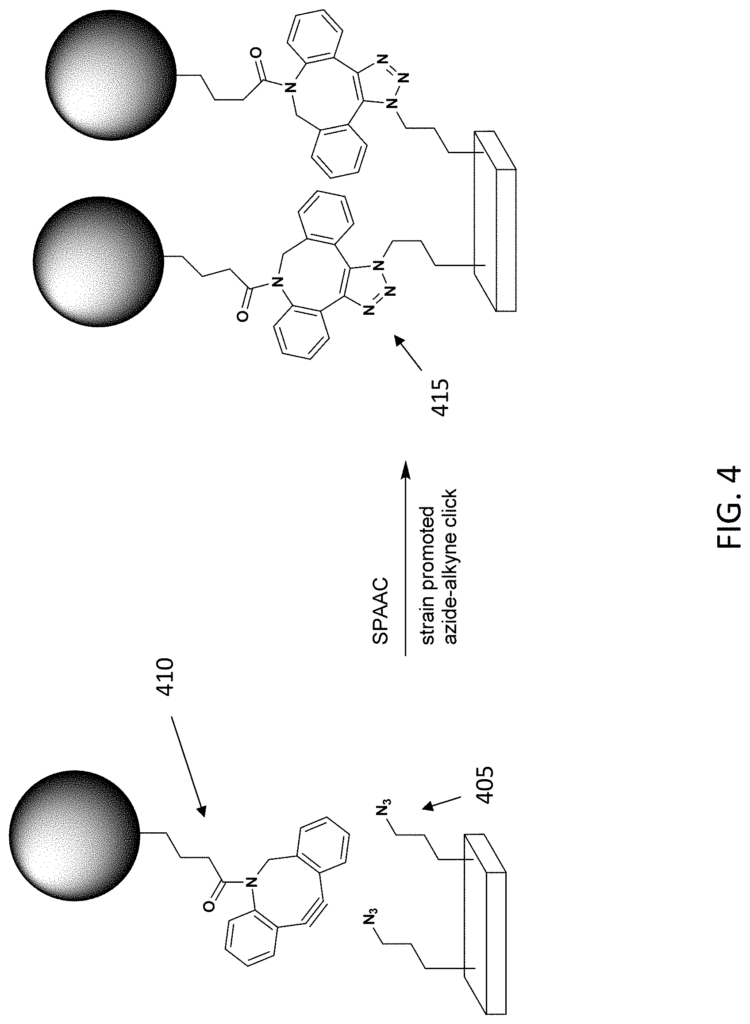
Click here to view the patent on Google Patents.
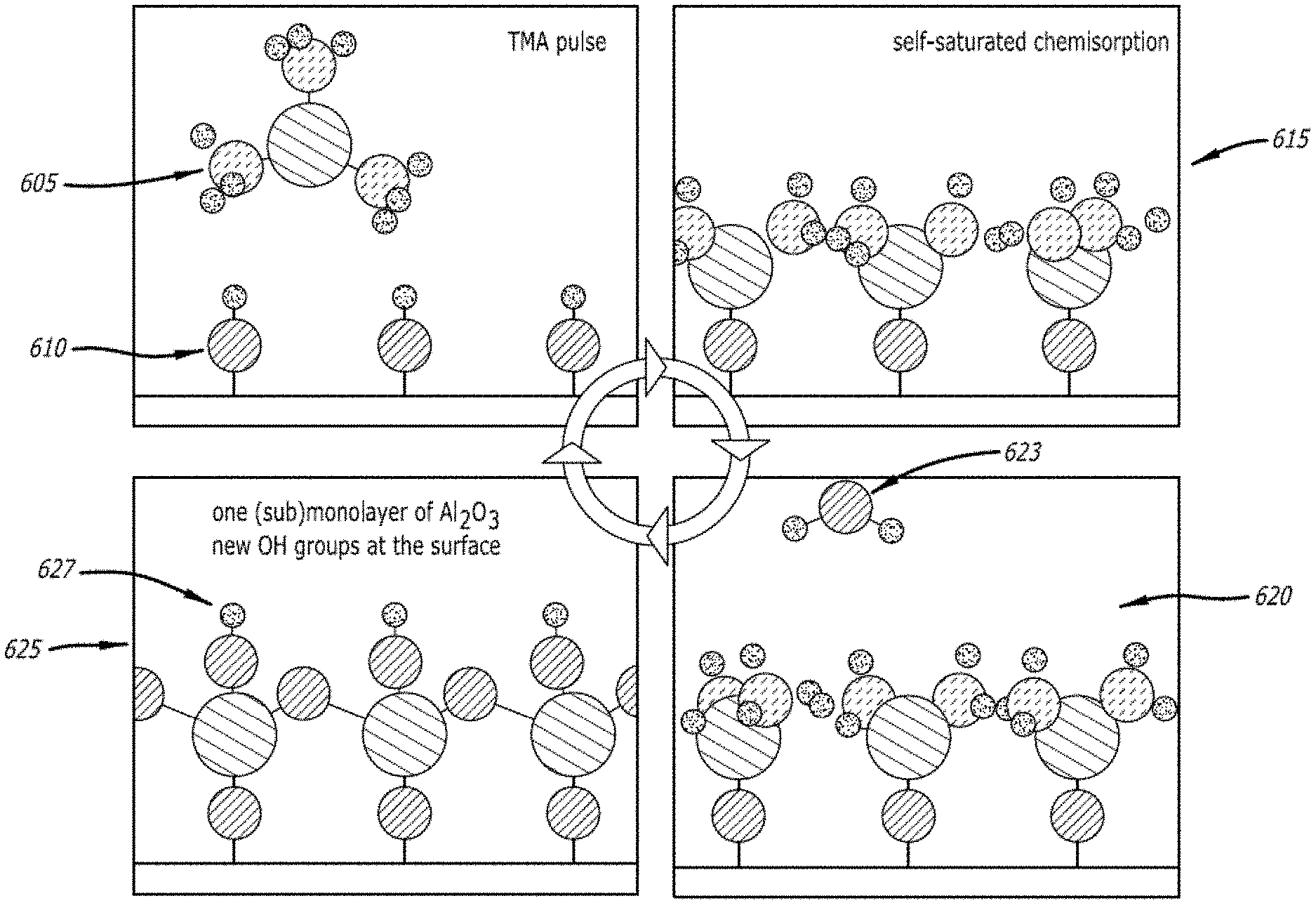
Leave a Reply